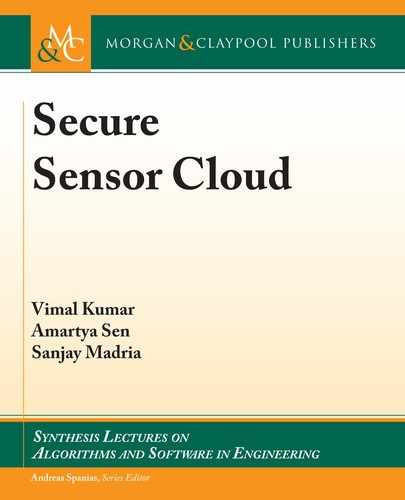
Series Editor: Andreas Spanias, Arizona State University
Secure Sensor Cloud
Vimal Kumar, University of Waikato
Amartya Sen, Oakland University
Sanjay Madria, Missouri University of Science and Technology
e sensor cloud is a new model of computing paradigm for Wireless Sensor Networks (WSNs), which facilitates
resource sharing and provides a platform to integrate dierent sensor networks where multiple users can build their own
sensing applications at the same time. It enables a multi-user on-demand sensory system, where computing, sensing,
and wireless network resources are shared among applications. erefore, it has inherent challenges for providing
security and privacy across the sensor cloud infrastructure. With the integration of WSNs with dierent ownerships,
and users running a variety of applications including their own code, there is a need for a risk assessment mechanism
to estimate the likelihood and impact of attacks on the life of the network. e data being generated by the wireless
sensors in a sensor cloud need to be protected against adversaries, which may be outsiders as well as insiders. Similarly,
the code disseminated to the sensors within the sensor cloud needs to be protected against inside and outside adversaries.
Moreover, since the wireless sensors cannot support complex and energy-intensive measures, the lightweight schemes
for integrity, security, and privacy of the data have to be redesigned.
e book starts with the motivation and architecture discussion of a sensor cloud. Due to the integration of
multiple WSNs running user-owned applications and code, the possibility of attacks is more likely. us, next, we discuss
a risk assessment mechanism to estimate the likelihood and impact of attacks on these WSNs in a sensor cloud using
a framework that allows the security administrator to better understand the threats present and take necessary actions.
en, we discuss integrity and privacy preserving data aggregation in a sensor cloud as it becomes harder to protect data
in this environment. Integrity of data can be compromised as it becomes easier for an attacker to inject false data in
a sensor cloud, and due to hop by hop nature, privacy of data could be leaked as well. Next, the book discusses a ne-
grained access control scheme which works on the secure aggregated data in a sensor cloud. is scheme uses Attribute
Based Encryption (ABE) to achieve the objective. Furthermore, to securely and eciently disseminate application
code in sensor cloud, we present a secure code dissemination algorithm which rst reduces the amount of code to be
transmitted from the base station to the sensor nodes. It then uses Symmetric Proxy Re-encryption along with Bloom
lters and Hash-based Message Authentication Code (HMACs) to protect the code against eavesdropping and false
code injection attacks.
store.morganclaypool.com
About SYNTHESIS
This volume is a printed version of a work that appears in the Synthesis
Digital Library of Engineering and Computer Science. Synthesis
books provide concise, original presentations of important research and
development topics, published quickly, in digital and print formats.
KUMAR • SEN • MADRIA SECURE SENSOR CLOUD MORGAN & CLAYPOOL
Series ISSN: 1938-1727
Secure
Sensor Cloud
Vimal Kumar
Amartya Sen
Sanjay Madria
store.morganclaypool.com
Secure Sensor Cloud

Synthesis Lectures on
Algorithms and Software in
Engineering
Editor
Andreas Spanias, Arizona State University
Secure Sensor Cloud
Vimal Kumar, Amartya Sen, and Sanjay Madria
2018
Sensor Analysis for the Internet of ings
Michael Stanley and Jongmin Lee
2018
Virtual Design of an Audio Lifelogging System: Tools for IoT Systems
Brian Mears and Mohit Shah
2016
Despeckle Filtering for Ultrasound Imaging and Video, Volume II: Selected Applications,
Second Edition
Christos P. Loizou and Constantinos S. Pattichis
2015
Despeckle Filtering for Ultrasound Imaging and Video, Volume I: Algorithms and
Software, Second Edition
Christos P. Loizou and Constantinos S. Pattichis
2015
Latency and Distortion of Electromagnetic Trackers for Augmented Reality Systems
Henry Himberg and Yuichi Motai
2014
Bandwidth Extension of Speech Using Perceptual Criteria
Visar Berisha, Steven Sandoval, and Julie Liss
2013
iii
Control Grid Motion Estimation for Efficient Application of Optical Flow
Christine M. Zwart and David H. Frakes
2013
Sparse Representations for Radar with MATLAB ™ Examples
Peter Knee
2012
Analysis of the MPEG-1 Layer III (MP3) Algorithm Using MATLAB
Jayaraman J. iagarajan and Andreas Spanias
2011
eory and Applications of Gaussian Quadrature Methods
Narayan Kovvali
2011
Algorithms and Software for Predictive and Perceptual Modeling of Speech
Venkatraman Atti
2011
Adaptive High-Resolution Sensor Waveform Design for Tracking
Ioannis Kyriakides, Darryl Morrell, and Antonia Papandreou-Suppappola
2010
MATLAB™ Software for the Code Excited Linear Prediction Algorithm: e Federal
Standard-1016
Karthikeyan N. Ramamurthy and Andreas S. Spanias
2010
OFDM Systems for Wireless Communications
Adarsh B. Narasimhamurthy, Mahesh K. Banavar, and Cihan Tepedelenliouglu
2010
Advances in Modern Blind Signal Separation Algorithms: eory and Applications
Kostas Kokkinakis and Philipos C. Loizou
2010
Advances in Waveform-Agile Sensing for Tracking
Sandeep Prasad Sira, Antonia Papandreou-Suppappola, and Darryl Morrell
2008
Despeckle Filtering Algorithms and Software for Ultrasound Imaging
Christos P. Loizou and Constantinos S. Pattichis
2008
..................Content has been hidden....................
You can't read the all page of ebook, please click here login for view all page.
